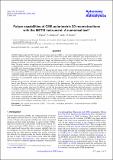Files in this item
Future capabilities of CME polarimetric 3D reconstructions with the METIS instrument : a numerical test
Item metadata
| dc.contributor.author | Pagano, Paolo | |
| dc.contributor.author | Bemporad, A | |
| dc.contributor.author | Mackay, Duncan Hendry | |
| dc.date.accessioned | 2015-11-05T15:40:02Z | |
| dc.date.available | 2015-11-05T15:40:02Z | |
| dc.date.issued | 2015-10 | |
| dc.identifier | 223497696 | |
| dc.identifier | c0d930b7-450f-4471-99eb-4e2364cace94 | |
| dc.identifier | 84943778173 | |
| dc.identifier | 000363538500072 | |
| dc.identifier.citation | Pagano , P , Bemporad , A & Mackay , D H 2015 , ' Future capabilities of CME polarimetric 3D reconstructions with the METIS instrument : a numerical test ' , Astronomy & Astrophysics , vol. 582 , A72 . https://doi.org/10.1051/0004-6361/201425462 | en |
| dc.identifier.issn | 0004-6361 | |
| dc.identifier.other | ORCID: /0000-0001-6065-8531/work/58055431 | |
| dc.identifier.uri | https://hdl.handle.net/10023/7748 | |
| dc.description | D.H.M. would like to thank STFC and the Leverhulme Trust for their financial support. P.P. would like to thank STFC and the Leverhulme Trust. The computational work for this paper was carried out on the joint STFC and SFC (SRIF) funded cluster at the University of St Andrews (Scotland, UK). | en |
| dc.description.abstract | Context. Understanding the 3D structure of coronal mass ejections (CMEs) is crucial for understanding the nature and origin of solar eruptions. However, owing to the optical thinness of the solar corona we can only observe the line of sight integrated emission. As a consequence the resulting projection effects hide the true 3D structure of CMEs. To derive information on the 3D structure of CMEs from white-light (total and polarized brightness) images, the polarization ratio technique is widely used. The soon-to-be-launched METIS coronagraph on board Solar Orbiter will use this technique to produce new polarimetric images. Aims. This work considers the application of the polarization ratio technique to synthetic CME observations from METIS. In particular we determine the accuracy at which the position of the centre of mass, direction and speed of propagation, and the column density of the CME can be determined along the line of sight. Methods. We perform a 3D MHD simulation of a flux rope ejection where a CME is produced. From the simulation we (i) synthesize the corresponding METIS white-light (total and polarized brightness) images and (ii) apply the polarization ratio technique to these synthesized images and compare the results with the known density distribution from the MHD simulation. In addition, we use recent results that consider how the position of a single blob of plasma is measured depending on its projected position in the plane of the sky. From this we can interpret the results of the polarization ratio technique and give an estimation of the error associated with derived parameters. Results. We find that the polarization ratio technique reproduces with high accuracy the position of the centre of mass along the line of sight. However, some errors are inherently associated with this determination. The polarization ratio technique also allows information to be derived on the real 3D direction of propagation of the CME. The determination of this is of fundamental importance for future space weather forecasting. In addition, we find that the column density derived from white-light images is accurate and we propose an improved technique where the combined use of the polarization ratio technique and white-light images minimizes the error in the estimation of column densities. Moreover, by applying the comparison to a set of snapshots of the simulation we can also assess the errors related to the trajectory and the expansion of the CME. Conclusions. Our method allows us to thoroughly test the performance of the polarization ratio technique and allows a determination of the errors associated with it, which means that it can be used to quantify the results from the analysis of the forthcoming METIS observations in white light (total and polarized brightness). Finally, we describe a satellite observing configuration relative to the Earth that can allow the technique to be efficiently used for space weather predictions. | |
| dc.format.extent | 12 | |
| dc.format.extent | 3231359 | |
| dc.language.iso | eng | |
| dc.relation.ispartof | Astronomy & Astrophysics | en |
| dc.subject | Sun: coronal mass ejections (CMEs) | en |
| dc.subject | Sun: corona | en |
| dc.subject | Techniques: polarimetric | en |
| dc.subject | Magnetohydrodynamics (MHD) | en |
| dc.subject | Sun: filaments, prominences | en |
| dc.subject | QC Physics | en |
| dc.subject | QB Astronomy | en |
| dc.subject | NDAS | en |
| dc.subject.lcc | QC | en |
| dc.subject.lcc | QB | en |
| dc.title | Future capabilities of CME polarimetric 3D reconstructions with the METIS instrument : a numerical test | en |
| dc.type | Journal article | en |
| dc.contributor.sponsor | Science & Technology Facilities Council | en |
| dc.contributor.sponsor | The Leverhulme Trust | en |
| dc.contributor.institution | University of St Andrews. Applied Mathematics | en |
| dc.identifier.doi | https://doi.org/10.1051/0004-6361/201425462 | |
| dc.description.status | Peer reviewed | en |
| dc.identifier.grantnumber | ST/K000950/1 | en |
| dc.identifier.grantnumber | RPG-305 | en |
This item appears in the following Collection(s)
Items in the St Andrews Research Repository are protected by copyright, with all rights reserved, unless otherwise indicated.

